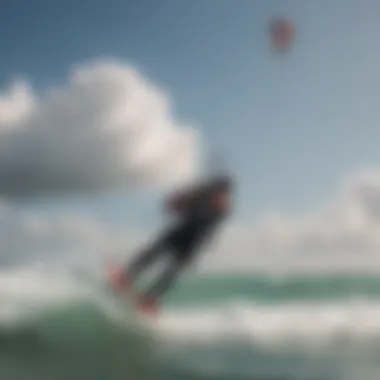Unveiling the Significance of Weather Flow Meters in Kitesurfing and Kiteboarding


Equipment Reviews
When engaging in the exhilarating sports of kitesurfing and kiteboarding, having the right equipment is paramount. Varied kite models saturate the market with distinct features and performances tailored to individual preferences. Kite shapes come in diverse designs, such as bow, delta, hybrid, providing different flying dynamics. Sizes range from compact to large, catering to wind conditions and rider skills. The choice of materials, whether ripstop nylon, polyester, or specialized fabrics, impacts durability and aerodynamics. Reputable brands like Cabrinha, Naish, and Duotone dominate the scene, each offering a unique blend of innovation and quality.
Twintips and directional boards are essential components in kiteboarding, with designs optimized for specific riding styles and conditions. Twintip boards, symmetrically shaped with upturned tips, excel in freestyle maneuvers and tricks with their versatile performance. In contrast, directional boards, sleek and elongated, enhance wave riding and ensure stability in varying water conditions. Construction materials like foam core, wood core, or carbon fiber influence weight, flex, and responsiveness, shaping the riding experience for kiteboarders.
Accessories play a crucial role in optimizing safety and comfort during kitesurfing and kiteboarding sessions. Harnesses securely attach riders to their kites, distributing pull forces and reducing fatigue. Choosing appropriate lines, whether spectra or dyneema, impacts kite control and responsiveness. Reliable pumps ensure quick inflation of kites, while safety gear like helmets, vests, and impact vests protect against injuries. Understanding the importance of each accessory is fundamental for a smooth and enjoyable kiting experience.
Introduction
Weather flow meters hold a vital role in the realm of kitesurfing and kiteboarding. These instruments are not merely accessories but rather essential tools that significantly impact the safety, performance, and overall experience of enthusiasts in these adrenaline-pumping sports. Understanding the nuances of weather flow meters is paramount for individuals stepping into these activities or seasoned riders looking to further enhance their skills and enjoyment.
Overview of Kitesurfing and Kiteboarding
Kitesurfing and kiteboarding are gravity-defying water sports that combine elements of surfing, wakeboarding, and windsurfing. Participants harness the power of the wind using a kite and a board to glide across the water's surface or perform incredible aerial maneuvers. These high-intensity activities demand skill, strength, and a deep connection with the natural elements, making them both thrilling and challenging pursuits for athletes seeking excitement and adventure.
Role of Weather Conditions
In kitesurfing and kiteboarding, weather conditions play a pivotal role in determining the feasibility and safety of engaging in these sports. Variables such as wind speed, direction, and consistency are crucial factors that directly influence the ability of riders to control their kites and boards effectively. Understanding weather patterns, microclimates, and seasonal variations is essential for enthusiasts to assess the risks, select appropriate gear, and plan their sessions accordingly. With the right knowledge of weather conditions, participants can maximize their time on the water while minimizing potential hazards and mishaps.
Understanding Weather Flow Meters
In the realm of kitesurfing and kiteboarding, understanding weather flow meters holds paramount importance. These devices act as the gatekeepers of crucial data that can dictate the safety, performance, and overall experience of participants in these exhilarating sports. By comprehending how weather flow meters operate and their significance, riders, whether novices or experts, can make informed decisions that may just be the difference between an unforgettable session and a potential hazard.


Definition and Function
Weather flow meters, in essence, serve as the invaluable tools that measure and monitor key weather elements essential for kitesurfing and kiteboarding. Their primary function lies in gauging parameters like wind speed, wind direction, and atmospheric pressure, providing real-time data that aids riders in understanding the environmental conditions. These meters act as the eyes and ears of riders, alerting them to any changes in weather patterns that could impact their sport.
Types of Weather Flow Meters
When delving into the realm of weather flow meters, three primary types stand out: anemometers, wind vanes, and barometers.
Anemometers
Among these, anemometers play a pivotal role in gathering data on wind speed. This data is crucial for riders as it directly influences their ability to harness the wind's power effectively. Anemometers come in various forms, from cup anemometers to sonic anemometers, each offering unique advantages and intricacies that cater to different kitesurfing and kiteboarding needs. Understanding the nuances of anemometers can give riders a competitive edge, allowing them to choose the most suitable type for their specific riding style and preferences.
Wind Vanes
Complementing anemometers, wind vanes focus on determining wind direction. Knowing the wind direction is key for riders to navigate effectively and perform maneuvers with precision. Wind vanes, with their ability to accurately detect wind angles, empower riders to make informed decisions based on wind patterns, ultimately enhancing their riding experience.
Barometers
Barometers, on the other hand, contribute by measuring atmospheric pressure variations. While this aspect may seem less obvious than wind speed and direction, changes in pressure can signal approaching weather changes, such as storms or shifts in wind intensity. By integrating barometric data into their weather analysis, riders can proactively adapt to evolving conditions, ensuring both safety and optimal performance.
Each type of weather flow meter brings a unique set of benefits and considerations to the table, catering to different facets of kitesurfing and kiteboarding and empowering riders with the knowledge needed to thrive in varying weather scenarios.
Significance in Kitesurfing and Kiteboarding


In the realm of kitesurfing and kiteboarding, the significance of weather flow meters cannot be overstated. These devices serve as crucial tools that aid enthusiasts in navigating the dynamic and ever-changing conditions of wind and weather. Safety within these high-adrenaline sports is paramount, and weather flow meters play a pivotal role in ensuring that riders have the necessary information to make informed decisions. By providing real-time data on wind speed, direction, and other meteorological factors, these instruments empower kitesurfers and kiteboarders to assess the conditions effectively before hitting the water.
Safety Precautions
When it comes to kitesurfing and kiteboarding, safety is non-negotiable. Weather flow meters contribute significantly to enhancing safety levels by offering reliable insights into various weather parameters. By understanding wind speed and direction, riders can preemptively anticipate changing conditions and adjust their strategies accordingly. Additionally, these meters help in identifying potential weather hazards, such as sudden gusts or shifts in wind patterns, allowing athletes to take necessary precautions to avoid accidents or mishaps. Adhering to safety protocols and utilizing the data provided by weather flow meters can be lifesaving in extreme sports like kitesurfing and kiteboarding.
Performance Optimization
Optimizing performance in kitesurfing and kiteboarding relies heavily on leveraging weather flow meters effectively. These instruments enable athletes to fine-tune their skills by harnessing the power of wind conditions to enhance speed, agility, and overall maneuverability. By gauging wind speed and direction accurately, riders can make strategic decisions during their sessions, such as selecting the ideal kite size or adjusting their technique to maximize performance. Weather flow meters act as performance enhancers, allowing kitesurfers and kiteboarders to push their limits while maintaining control and precision in their movements.
Choosing the Right Conditions
Selecting the optimal weather conditions is a critical aspect of kitesurfing and kiteboarding. Weather flow meters aid riders in making informed choices by providing data on wind intensity, gust patterns, and thermal effects. Choosing the right conditions involves analyzing this information to determine the suitability for a successful and enjoyable session on the water. By understanding the nuances of weather flow data, athletes can select the perfect timing and location to engage in their sport, ensuring a gratifying experience while mitigating potential risks. The ability to choose the right conditions based on insights from weather flow meters is key to maximizing the thrill and excitement of kitesurfing and kiteboarding adventures.
Utilizing Weather Flow Data
In the realm of kitesurfing and kiteboarding, an in-depth understanding and effective utilization of weather flow data stand as critical components for enthusiasts seeking optimal performance and safety. The significance of leveraging weather flow data lies in its ability to provide key insights into prevailing environmental conditions, specifically wind speed and direction, which are paramount for a successful kitesurfing or kiteboarding session. By harnessing this data, participants can make informed decisions regarding when to embark on their thrilling rides, ensuring a tailored experience that maximizes enjoyment and minimizes risks. Moreover, the utilization of weather flow data serves as a tool for enhancing skill progression, as riders can align their techniques with the prevailing wind dynamics, thereby refining their proficiency in maneuvering through varying wind patterns on the water. This nuanced approach not only elevates the overall kitesurfing and kiteboarding experience but also fosters a deeper connection with the natural elements that shape these exhilarating sports.
Interpreting Wind Speed and Direction
A fundamental aspect of utilizing weather flow data in kitesurfing and kiteboarding revolves around the nuanced interpretation of wind speed and direction. Wind conditions play a pivotal role in determining the feasibility and success of a ride, making the interpretation of these factors imperative for enthusiasts. Understanding wind speed allows riders to gauge the intensity of airflow, influencing their choice of equipment and techniques during a session. Additionally, comprehending wind direction is crucial for effective navigation on the water, as it dictates the course of travel and maneuvering possibilities. By honing the skill of interpreting wind speed and direction through weather flow data, kitesurfers and kiteboarders can optimize their performance, remain safe on the water, and capitalize on the diverse wind patterns present in their riding area.
Forecast Analysis


Forecast analysis stands as a valuable tool for kitesurfing and kiteboarding aficionados, enabling them to preemptively plan their riding adventures with heightened precision and foresight. By scrutinizing weather forecasts that incorporate data from weather flow meters, participants can anticipate upcoming wind conditions, temperature changes, and other pertinent environmental details that impact their riding experience. This proactive approach equips riders with the knowledge needed to strategize their sessions, adjust their equipment selections, and adapt their riding style according to the expected weather patterns. Forecast analysis acts as a guiding compass for kitesurfers and kiteboarders, empowering them to make informed decisions that optimize their enjoyment, safety, and overall performance on the water.
Real-time Monitoring
Real-time monitoring emerges as a key practice in the arsenal of kitesurfing and kiteboarding enthusiasts, offering them instantaneous access to crucial weather flow data during their riding escapades. Through real-time monitoring, riders can track shifts in wind speed and direction as they occur, allowing for on-the-fly adjustments to their riding approach. This agile response to changing environmental conditions enhances safety measures, ensures efficient use of wind power, and elevates the overall riding experience by adapting to the dynamic nature of wind patterns on the water. Real-time monitoring not only fosters a sense of control and adaptability but also instills a deeper appreciation for the symbiotic relationship between riders and the ever-changing atmospheric elements they navigate during their kitesurfing and kiteboarding endeavors.
Factors Impacting Weather Flow Meter Readings
Weather flow meter readings are crucial for kitesurfing and kiteboarding, as they directly impact safety and performance. Understanding the various factors that can influence these readings is essential for enthusiasts. Topographical features play a significant role in determining wind patterns and velocities, affecting the accuracy of weather flow meters. For instance, mountains can cause wind to accelerate or decelerate, leading to inaccurate data if not considered. Coastal areas may experience different wind behaviors due to proximity to the sea.
Local microclimates also play a crucial role in weather flow meter readings. Factors such as urban areas, vegetation, and buildings can disrupt wind flow, leading to turbulent conditions that make it challenging to get precise measurements with the meters. Microclimates can create wind tunnels or pockets of still air, impacting the data gathered by the instruments.
Seasonal variations introduce another layer of complexity to weather flow meter readings. Changes in temperature, humidity, and air pressure throughout the year can significantly alter wind patterns and speeds. For kitesurfers and kiteboarders, understanding how seasonal variations affect wind conditions is vital for adapting their equipment and techniques accordingly. Anticipating these changes based on historical data can help enthusiasts make informed decisions about when and where to pursue their sports.
Best Practices for Weather Monitoring
In the realm of kitesurfing and kiteboarding, understanding and implementing best practices for weather monitoring stand as crucial pillars for ensuring a safe, efficient, and enjoyable experience for riders. Weather conditions can swiftly change, impacting the dynamics of wind patterns and other atmospheric elements that heavily influence these sports' performance and safety. By adhering to best practices for weather monitoring, enthusiasts can stay ahead of potentially risky situations, optimize their skills, and extract maximum satisfaction from their kitesurfing or kiteboarding sessions. Whether a novice or a seasoned rider, integrating these practices into one's routine can lead to enhanced overall proficiency and a deeper appreciation for the sport.
Ensuring the accuracy of weather flow meters through routine calibration is a fundamental aspect of maintaining top-notch monitoring quality for kitesurfing and kiteboarding excursions. Routine calibration involves the regular assessment and adjustment of these instruments to guarantee precise readings of wind speed, direction, and other vital data. By calibrating weather flow meters at consistent intervals, riders can trust the information they receive, make well-informed decisions based on accurate data, and ultimately heighten their overall safety and performance levels on the water.
When it comes to maintaining weather flow meters, adhering to a set of critical tips can prolong the lifespan and efficiency of these essential instruments. Regular inspection and cleaning of the equipment, ensuring all components are in top working condition, and promptly addressing any issues that arise are key practices in maintaining weather meters effectively. Additionally, storing the meters in a safe, dry environment when not in use, avoiding exposure to extreme temperatures or elements, and following manufacturer guidelines for care and maintenance can significantly extend the longevity of these devices, ensuring reliable performance for countless kitesurfing and kiteboarding adventures ahead.
Conclusion
In the grand scheme of kitesurfing and kiteboarding, the Conclusion serves as the pinnacle of wisdom and insight gained throughout this article. It encapsulates the essence of why weather flow meters are indispensable tools for riders of all skill levels. By dissecting the intricacies of weather monitoring, individuals can unlock a newfound realm of safety precautions, performance optimization, and the ability to select optimal conditions for their adventures. The Conclusion transcends mere words; it symbolizes a conduit for elevating the kitesurfing and kiteboarding experience to unmatched heights, ensuring that enthusiasts can engage in these adrenaline-fueled sports with confidence and proficiency.
Enhancing the Kitesurfing and Kiteboarding Experience
Venturing into the depths of enhancing the kitesurfing and kiteboarding experience unveils a world where precision and calculated decisions reign supreme. Weather flow meters act as the compass guiding riders through the turbulent seas of unpredictable conditions. Their significance lies not only in offering data but also in empowering individuals to harness the elements in their favor. By embracing these instruments, enthusiasts can navigate the fine line between exhilaration and peril, steering towards a path where safety, performance, and joy converge harmoniously. The pulse of the wind, the dance of the waves - all await those equipped with the knowledge and understanding fostered through weather flow meters. It is within this realm that the essence of kitesurfing and kiteboarding truly blossoms, transforming each escapade into a symphony of skill, nature, and human spirit.







